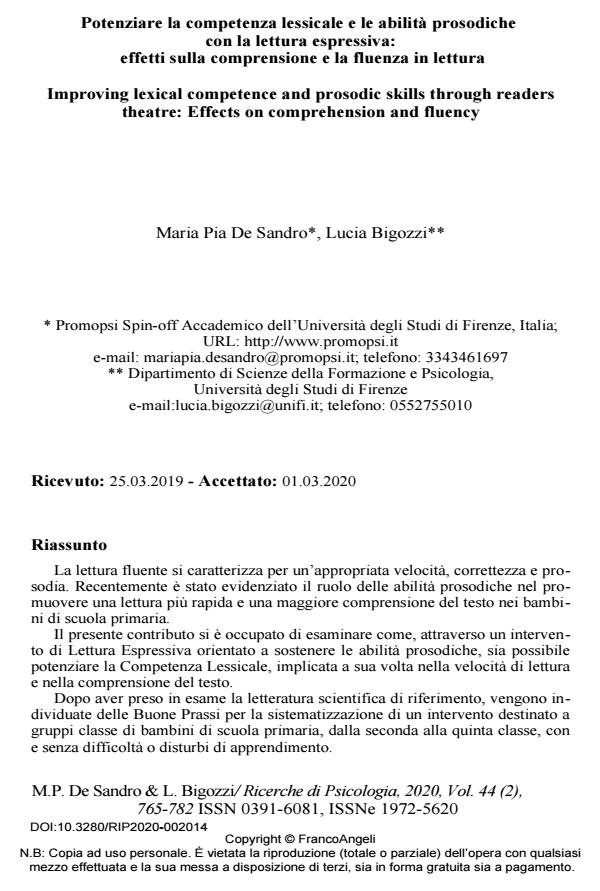Potenziare la competenza lessicale e le abilità prosodiche con la lettura espressiva: effetti sulla comprensione e la fluenza in lettura
Titolo Rivista RICERCHE DI PSICOLOGIA
Autori/Curatori Maria Pia De Sandro, Lucia Bigozzi
Anno di pubblicazione 2020 Fascicolo 2020/2
Lingua Italiano Numero pagine 18 P. 765-782 Dimensione file 241 KB
DOI 10.3280/RIP2020-002014
Il DOI è il codice a barre della proprietà intellettuale: per saperne di più
clicca qui
Qui sotto puoi vedere in anteprima la prima pagina di questo articolo.
Se questo articolo ti interessa, lo puoi acquistare (e scaricare in formato pdf) seguendo le facili indicazioni per acquistare il download credit. Acquista Download Credits per scaricare questo Articolo in formato PDF

FrancoAngeli è membro della Publishers International Linking Association, Inc (PILA)associazione indipendente e non profit per facilitare (attraverso i servizi tecnologici implementati da CrossRef.org) l’accesso degli studiosi ai contenuti digitali nelle pubblicazioni professionali e scientifiche
La lettura fluente si caratterizza per un’appropriata velocità, correttezza e prosodia. Recentemente è stato evidenziato il ruolo delle abilità prosodiche nel promuovere una lettura più rapida e una maggiore comprensione del testo nei bambini di scuola primaria. Il presente contributo si è occupato di esaminare come, attraverso un intervento di Lettura Espressiva orientato a sostenere le abilità prosodiche, sia possibi-le potenziare la Competenza Lessicale, implicata a sua volta nella velocità di let-tura e nella comprensione del testo. Dopo aver preso in esame la letteratura scientifica di riferimento, vengono in-dividuate delle Buone Prassi per la sistematizzazione di un intervento destinato a gruppi classe di bambini di scuola primaria, dalla seconda alla quinta classe, con e senza difficoltà o disturbi di apprendimento.
Parole chiave:Lettura espressiva, competenza lessicale, fluenza, prosodia, comprensione in lettura.
- THE RELATIONSHIP BETWEEN INFERENTIAL PROCESSING AND TEXT PROCESSING: A DEVELOPMENTAL STUDY Agata Maltese, Annamaria Pepi, Lidia Scifo, in Problems of Psychology in the 21st Century /2012 pp.21
DOI: 10.33225/ppc/12.02.21
Maria Pia De Sandro, Lucia Bigozzi, Potenziare la competenza lessicale e le abilità prosodiche con la lettura espressiva: effetti sulla comprensione e la fluenza in lettura in "RICERCHE DI PSICOLOGIA " 2/2020, pp 765-782, DOI: 10.3280/RIP2020-002014